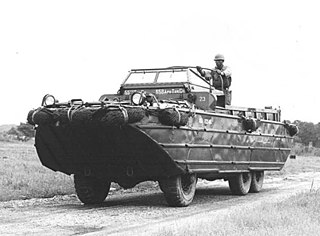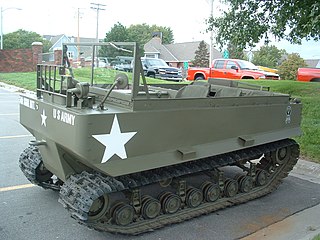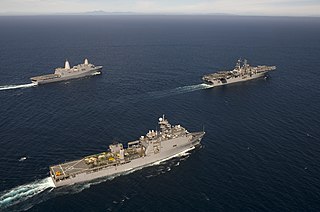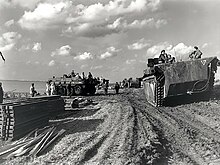
Walcheren is a region and former island in the Dutch province of Zeeland at the mouth of the Scheldt estuary. It lies between the Eastern Scheldt in the north and the Western Scheldt in the south and is roughly the shape of a rhombus. The two sides facing the North Sea consist of dunes and the rest of its coastline is made up of dykes. Middelburg, the provincial capital, lies at Walcheren's centre. Vlissingen, 9 kilometres (5.6 mi) to the south, is the main harbour and the third municipality is Veere.

An amphibious vehicle is a vehicle that works both on land and on or under water. Amphibious vehicles include amphibious bicycles, ATVs, cars, buses, trucks, railway vehicles, combat vehicles, and hovercraft.

Landing craft are small and medium seagoing watercraft, such as boats and barges, used to convey a landing force from the sea to the shore during an amphibious assault. The term excludes landing ships, which are larger. Production of landing craft peaked during World War II, with a significant number of different designs produced in large quantities by the United Kingdom and United States.

The Amphibious Vehicle, Tracked (LVT) is an amphibious warfare vehicle and amphibious landing craft, introduced by the United States Navy and United States Marine Corps. The United States Army, Canadian Army and British Army used several LVT models during World War II, and referred to those vehicles as "Landing Vehicle, Tracked."

The Siegfried Line campaign was a phase in the Western European campaign of World War II, which involved engagments near the German defensive Siegfried Line.

The DUKW is a six-wheel-drive amphibious modification of the 2+1⁄2-ton CCKW trucks used by the U.S. military during World War II and the Korean War.

The Battle of the Scheldt in World War II was a series of military operations to open up the Scheldt river between Antwerp and the North Sea for shipping, so that Antwerp's port could be used to supply the Allies in north-west Europe. The operations were carried out by the First Canadian Army, with assistance from Polish and British units which had been attached. The action was under the acting command of the First Canadian's Lieutenant-General Guy Simonds. The battle took place in the vicinity of the Scheldt river in northern Belgium and southwestern Netherlands from 2 October to 8 November 1944.

The M29 Weasel is a World War II tracked vehicle designed for operation in snow. Built by Studebaker, Weasels were also used in sandy, muddy, and desert terrains, including towing loads over terrain wheeled vehicles could not negotiate as in the U.S. Marine invasions of Iwo Jima and Okinawa.

The Willys MB and the Ford GPW, both formally called the U.S. Army truck, 1⁄4‑ton, 4×4, command reconnaissance, commonly known as the Willys Jeep, Jeep, or jeep, and sometimes referred to by its Standard Army vehicle supply nr. G-503, were highly successful American off-road capable, light military utility vehicles. Well over 600,000 were built to a single standardized design, for the United States and the Allied forces in World War II, from 1941 until 1945. This also made it the world's first mass-produced four-wheel-drive car, built in six-figure numbers.

The Ford GPA "Seep", with supply catalog number G504, was an amphibious version of the World War II Ford GPW jeep. Over 12 thousand were made and they served with Allied forces in the many theatres of WW2, including the Pacific, Eastern front, and from D-day to the end. After the war as surplus they found many niche roles, and today examples can be found in museums collections or at military history shows.
The Battle of Walcheren Causeway was an engagement of the Battle of the Scheldt between the 5th Canadian Infantry Brigade, elements of the British 52nd (Lowland) Infantry Division and troops of the German 15th Army in 1944. It was the first of many conflicts on and around Walcheren Island during the Scheldt battles. It was also the second major battle fought over a terrain feature known as the Sloedam during the Second World War.

The PTS is a Soviet tracked amphibious transport. PTS stands for Plavayushchij Transportyer - Sryednyj or medium amphibious transport vehicle. Its industrial index was Ob'yekt 65.

An amphibious warfare ship is an amphibious vehicle warship employed to land and support ground forces, such as marines, on enemy territory during an amphibious assault.

The GMC CCKW, also known as "Jimmy", or the G-508 by its Ordnance Supply Catalog number, was a highly successful series of off-road capable, 21⁄2-ton, 6×6 trucks, built in large numbers to a standardized design for the U.S. Army, that saw heavy service, predominantly as cargo trucks, in both World War II and the Korean War. The original "Deuce and a Half", it formed the backbone of the famed Red Ball Express that kept Allied armies supplied as they pushed eastward after the Normandy invasion.

The Amphibious truck "Su-Ki" was a World War II Japanese military vehicle manufactured by the Toyota Motor Co., Ltd, similar in concept to the GMC DUKW. It entered service in 1943 and was used by Japanese forces in the Pacific during World War II.

The Jeep trailer was a small, 1⁄4 short ton payload rated, cargo trailer, designed in World War II, tailored to be towed by 1/4-ton jeeps. Versions of the quarter-ton jeep trailer remained in military use, by the U.S. or other countries, at least through to the 1990s.

The Dodge WC series is a prolific range of light 4WD and medium 6WD military utility trucks, produced by Chrysler under the Dodge and Fargo marques during World War II. Together with the 1⁄4-ton jeeps produced by Willys and Ford, the Dodge 1⁄2‑ton G-505 and 3⁄4‑ton G-502 trucks made up nearly all of the light 4WD trucks supplied to the U.S. military in WWII – with Dodge contributing some 337,500 4WD units.

An amphibious automobile is an automobile that is a means of transport viable on land as well as on or under water. They are unarmored for civilian use.

During World War II, the Allies faced an unprecedented challenge with numerous landing operations required both in the Pacific and Europe. This necessitated the design and construction of various landing, supply, and support craft. According to incomplete and imprecise data, thousands of landing craft were built for these operations during the war. The most numerous were assault vehicles and Infantry Landing Craft.



















